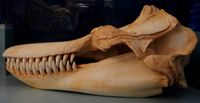Gnathostomata
Fossil range:
Late Ordovician - Recent |

Gnathostomata are jawed vertebrates
|
|
Scientific classification |
| Kingdom: |
Animalia
|
| Phylum: |
Chordata
|
| Subphylum: |
Vertebrata
|
| Infraphylum: |
Gnathostomata
|
|
| Classes |
Placodermi
Chondrichthyes
Acanthodii
Actinopterygii
Sarcopterygii |
Gnathostomata is the group of
vertebrates with jaws.
The group is traditionally a
superclass, including the familiar classes of
fish,
birds, and so forth, and a sister group of the jawless
vertebrates
Agnatha. However, recent genetic studies are causing a
reassessment of Gnathostomata as a grouping.
It is assumed the jaws evolved from anterior gill support
arches that had acquired a new role, being modified to pump
water over the gills by opening and closing the mouth more
effectively. The mouth could then grow bigger and wider,
making it possible to capture small prey. This close and
open mechanism would with time become stronger and tougher,
being transformed into real jaws. Modified dermal bones on
the surface of the skin would migrate into the mouth and
become primtive teeth.
Placoderms used sharp bony plates as teeth instead.
Other distinguishing characteristics of living
gnathostomates are the myelin sheathes of neurons, and an
adaptive immune system.
Taxonomy & Phylogeny
Subphylum Vertebrata
├─(unranked) Gnathostomatomorpha
└─Infraphylum Gnathostomata
├─Class Placodermi - extinct (armored gnathostomes)
└Microphylum Eugnathostomata (true jawed vertebrates)
├─Class Chondrichthyes (cartilagenous fish)
└(unranked) Teleostomi (Acanthodii & Osteichthyes)
├─Class Acanthodii - extinct ("spiny sharks")
└Superclass Osteichthyes (bony fish)
├─Class Actinopterygii (ray-finned fish)
└─Class Sarcopterygii (lobe-finned fish)
└Superclass Tetrapoda
├─Class Amphibia (amphibians)
└(unranked) Amniota (amniotic egg)
├─Class Sauropsida (reptiles or sauropsids)
│ └─Class Aves (birds)
└Class Synapsida
└─Class Mammalia (mammals)
Note lines show evolutionary relationships.
External links




